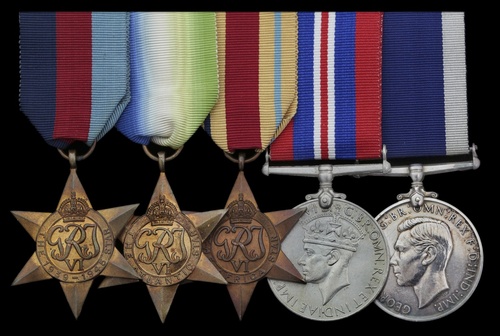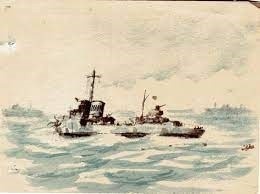Auction: 22002 - Orders, Decorations and Medals
Lot: 101
'That night, from a flat calm evening, it blew up Force 5-6, causing the Captain concern that Fort Branson's anchor chain could set off a nearby mine. Next morning, I watched our vehicles being unloaded onto the big Rhino barges run by the Sappers and went back to my cabin for a wash and brush up before breakfast. I was just doing this when there was a heck of a bang. I shot out on deck where I was appalled to see, two cables away, a corvette type of ship with her bows blown off to the 4.7 gun mounting. She was blowing off clouds of steam but slowly got under way, having eased the survivors away, and started heading for the beach adjoining the Mulberry caissons. We were all saddened on deck as no lifeboat was lowered to help those in the water and, in particular, one sailor who was manfully swimming towards the beach a long way ahead. Lifeboats were not lowered for fear of mines.
I then hurried back to my cabin and did three small water-colour sketches of what I had seen. In July 1994 I found these sketches and wrote to Navy News to ask if anyone could identify the ship. To my delight the next Navy News had several letters in it which gave her name as H.M.S. Orchis (K76). Naval Historical Branch stated that she was torpedoed by U-992 which, 14 days later, was sunk in the Dover Straits. Fifty of Orchis's crew were killed or missing. Survivors were picked up by MLs 150 and 196 and landed in Normandy. The injured men were later sent to England in the hospital ship St. Julian. H.M.S. Orchis was surveyed but found to be beyond economical repair and was broken up on site.'
Major Bill Wynn-Werninck recalls the loss of H.M.S. Orchis off Normandy in August 1944.
A Second World War campaign group of five awarded to Chief Petty Officer Stoker Mechanic J. R. I. Parry, Royal Navy
A long-served convoy escort rating, Parry was present aboard the sloop H.M.S. Falmouth when she destroyed the Italian submarine Galvani in June 1940 and aboard the corvette Orchis when she took-out the U-741 in August 1944
Just six days later, Orchis had her bow blown off by a torpedo and had to be grounded on Juno beach on the Normandy coast
1939-45 Star; Atlantic Star, clasp, France and Germany; Africa Star; War Medal 1939-45; Royal Navy L.S. & G.C., G.VI.R., 1st issue (KX. 80957 J. R. I. Parry, Ch. Sto., H.M.S. Onslow), nearly extremely fine (5)
John Roderick Ivor Parry was born in Neath, Glamorganshire on 14 January 1913 and entered the Royal Navy as Stoker 2nd Class in June 1931.
H.M.S. Falmouth - victory in the Gulf
By the outbreak of hostilities in September 1939, he was serving as a Leading Stoker in the sloop H.M.S. Falmouth and he was similarly employed when she destroyed the Italian submarine Galvani at the entrance of the Persian Gulf on 26 June 1940.
Caught on the surface by Falmouth's gunfire, the Galvani sustained further damage after a depth charge attack. Among Galvani's fatalities was Pietro Venuti, who was awarded a posthumous Gold Medal of Military Valour, for in locking himself in the torpedo room to prevent further flooding, he enabled the submarine to surface.
H.M.S. Saxifrage - life saver
Having them come ashore in October 1941, Parry served as a Stoker Petty Officer in the Flower-class corvette Saxifrage from February 1942 until April 1943, in which period he and his shipmates undertook a spate of notable rescue operations.
In July 1942, they picked up 35 survivors from the Putney Hill, off Puerto Rico, whilst in January 1943 they rescued 27 survivors from the British Vigilance off Barbados and 34 survivors from the Empire Lytton off the Canaries. Finally, in respect of Parry's time aboard, Saxifrage picked up 37 survivors from the Dutch merchantman Alderamin off Cape Farewell.
H.M.S. Orchis - another victory - eventual demise
In April 1943, he removed to the corvette Orchis, and he was similarly employed at the time of her loss off Normandy in August 1944.
In the interim, Orchis acted as a reinforcement escort to Atlantic convoy ONS 18 in September 1943, when six merchantmen were sunk, in addition to three escorting naval ships. Three U-Boats were taken out in retaliation.
Following the Normandy landings, Orchis acted as a cross-Channel escort and, on 15 August 1944, she destroyed the U-741. In a textbook operation, she held sonar contact before delivering two 'Hedgehog' and two depth-charge attacks, just one man escaping the doomed U-boat from the aft-torpedo hatch. He was picked up by Orchis.
But tragedy struck less than a week later, when, on the 21st, Orchis struck a mine which blew off her bows, all the way back to her 4-inch gun. She was run aground on Juno beach and declared a total loss.
Parry's final wartime appointment was in the destroyer Zealous, in which ship he served from October 1944 to October 1945.
Postscript
Having then been awarded his L.S. & G.C. Medal whilst serving in Onslow in May 1946, he was rated as a Chief Petty Officer Stoker Mechanic, but he died at the shore establishment H.M.S. Raleigh on 23 January 1953.
Subject to 20% VAT on Buyer’s Premium. For more information please view Terms and Conditions for Buyers.
Sold for
£160
Starting price
£100







